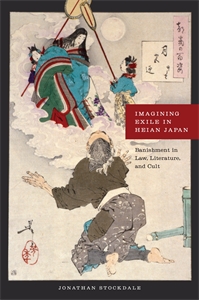Imagining Exile in Heian Japan: Banishment in Law, Literature, and Cult
- About the Book
-
For over three hundred years during the Heian period (794–1185), execution was customarily abolished in favor of banishment. During the same period, exile emerged widely as a concern within literature and legend, in poetry and diaries, and in the cultic imagination, as expressed in oracles and revelations. While exile was thus one sanction available to the state, it was also something more: a powerful trope through which members of court society imagined the banishment of gods and heavenly beings, of legendary and literary characters, and of historical figures, some transformed into spirits.
This compelling and well-researched volume is the first in English to explore the rich resonance of exile in the cultural life of the Japanese court. Rejecting the notion that such narratives merely reflect a timeless literary archetype, Jonathan Stockdale shows instead that in every case narratives of exile emerged from particular historical circumstances—moments in which elites in the capital sought to reveal and to re-imagine their world and the circulation of power within it. By exploring the relationship of banishment to the structures of inclusion and exclusion upon which Heian court society rested, Stockdale moves beyond the historiographical discussion of “center and margin” to offer instead a theory of exile itself.
Stockdale’s arguments are situated in astute and careful readings of Heian sources. His analysis of a literary narrative, the Tale of the Bamboo Cutter, for example, shows how Kaguyahime’s exile from the “Capital of the Moon” to earth implicitly portrays the world of the Heian court as a polluted periphery. His exploration of one of the most well-known historical instances of banishment, that of Sugawara Michizane, illustrates how the political sanction of exile could be met with a religious rejoinder through which an exiled noble is reinstated in divine form, first as a vengeful spirit and then as a deity worshipped at the highest levels of court society.
Imagining Exile in Heian Japan is a model of interdisciplinary scholarship that will appeal to anyone interested in the interwoven connections among the literature, politics, law, and religion of early and classical Japan.
- About the Author(s)
-
Jonathan Stockdale, Author
- Reviews and Endorsements
-
- By any meaningful measure, Imagining Exile is a major achievement. In gathering texts and topics usually relegated to separate studies, Stockdale does more than present a better picture of banishment in the Heian period and related corners of Japanese history. He models the curiosity and flexibility required in our own moment – and not just at work.
—Japanese Studies - On the whole, Stockdale’s is an interesting book, bringing together perspectives from the study of myth, literature, history, religion, and law. . . . anyone with a serious interest in the period would be well advised to read this book.
—Journal of Japanese Studies - Jonathan Stockdale’s Imagining Exile in Heian Japan: Banishment in Law, Literature, and Cult is a lively and comprehensive study of exile as historical practice and cultural trope during Japan’s classical age. . . . Imagining Exile is a thoughtful, clear, and engaging study of exile as a practice as well as a trope in literature, religion, history, and law during the Heian period and beyond. . . . Imagining Exile is a welcome addition to the field of early Japanese cultural studies and provides a good model for interdisciplinary approaches to the tropes and practices that continue to shape Japan today.
—Monumenta Nipponica - A history of Yasukuni Shrine has long been overdue. The shrine is a central element of the so-called history issue in East Asia and the debates concerning it cannot be understood properly without a solid grounding in its history. . . . Takenaka does a good job of steering clear of polemics. She engages critically the arguments of both Yasukuni supporters and detractors, and always has the reassuring tone of someone comfortable in her own scholarly perspective and approach. In sum, this book is simply a pleasure to read.
—H-Japan In addition to appealing to specialists in Japanese religious history, it should be of interest to anyone working on religion and punishment, as well as religion and literature or East Asian cultural history. . . . By examining representations of exile in myth, literature, religious cult, and law, Stockdale pushes us to think more broadly about social dynamics, particularly the construction of centers and margins through the practice of banishment, and the ironic tendency of exile to feed from alienation into chaos, even as it is used to impose order. His
work is both bold and admirable.
—American Academy of Religion- Stockdale in this work demonstrates a firm understanding and appreciation for Heian culture and his attention to the importance of the theme of banishment is very well placed. His thesis is clear and his use of examples from literature support his argument very well. The research is solid and the writing is clear. This is an enjoyable and quite fascinating read, and a highly original and important contribution to the study of Heian literature and culture.
—Asian Ethnology
- By any meaningful measure, Imagining Exile is a major achievement. In gathering texts and topics usually relegated to separate studies, Stockdale does more than present a better picture of banishment in the Heian period and related corners of Japanese history. He models the curiosity and flexibility required in our own moment – and not just at work.
- Supporting Resources
-





